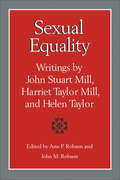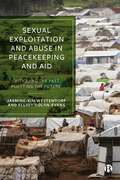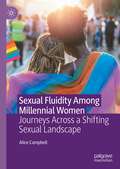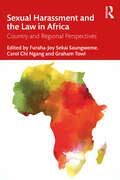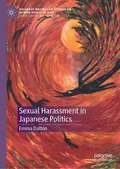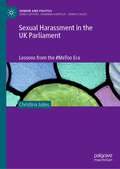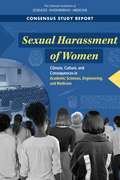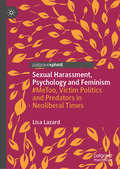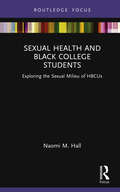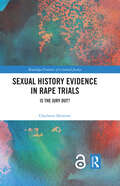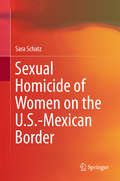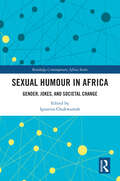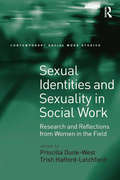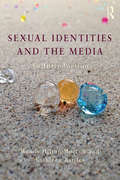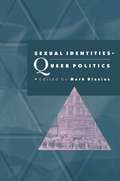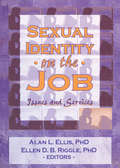- Table View
- List View
Sexual Equality: A Mill-Taylor Reader
by Ann P. RobsonAll the significant ideas in nineteenth-century English feminism can be found in the prose and thought of John Stuart Mill and in those of the two women central to his life: Harriet Taylor, who married him in 1851, and her daughter, Helen Taylor. Together they produced some of the most powerful and influential writings ever penned to promote women's equality, and it was to this family that the Victorian women's movement in England came to look for leadership, guidance, and money.In this volume, Ann Robson and John Robson bring together the writings and speeches from these three seminal thinkers on the subject of sexual equality. Some of these pieces have not been available in published form for more than a century. They cover such topics as love, sex, marriage, children, property, domestic relations, divorce, and suffrage.Sexual Equality is a necessary tool for understanding the development of ideas on women's issues in the Mill household. These ideas influenced thinking on sexual equality far beyond England and far past the Victorian period.
Sexual Exploitation and Abuse in Peacekeeping and Aid: Critiquing the Past, Plotting the Future
by Sarah Martin Dyan Mazurana Megan Daigle Henri Myrttinen Jane Connors Ai Kihara-Hunt Asmita Naik Nour Abu-Assab Nof Nasser-Eddin Junru Bian Emily Elderfield Sabrina White Alina Potts Ellie Kemp Leah Nyambeki Phoebe Donnelly Kathleen M JenningsIn 2003, the UN adopted a zero-tolerance policy on sexual exploitation and abuse by peacekeepers and aid workers. The policy arrived amid a series of scandals revealing sexual misconduct perpetrated against the very people peacekeeping and humanitarian missions were meant to protect. This edited collection, including contributions from academics and practitioners, highlights the challenges of preventing and responding to abuse in peacekeeping and aid work, and the unintended consequences of current approaches. It lays bare the structures of power, coloniality and racism that underpin abuse and hinder accountability while charting a path for future action. This eye-opening book will appeal to academics and students of the politics and practice of peacekeeping and humanitarianism, and to practitioners, policy makers and those working within the field.
Sexual Exploitation of Teenagers
by Jennifer Ann DrobacWhen we consider the concept of sexual abuse and harassment, our minds tend to jump either towards adults caught in unhealthy relationships or criminals who take advantage of children. But the millions of maturing teenagers who also deal with sexual harassment can fall between the cracks. When it comes to sexual relationships, adolescents pose a particular problem. Few teenagers possess all of the emotional and intellectual tools needed to navigate these threats, including the all too real advances made by supervisors, teachers, and mentors. In Sexual Exploitation of Teenagers, Jennifer Drobac explores the shockingly common problem of maturing adolescents who are harassed and exploited by adults in their lives. Reviewing the neuroscience and psychosocial evidence of adolescent development, she explains why teens are so vulnerable to adult harassers. Even today, in an age of increasing public awareness, criminal and civil law regarding the sexual abuse of minors remains tragically inept and irregular from state to state. Drobac uses six recent cases of teens suffering sexual harassment to illuminate the flaws and contradictions of this system, skillfully showing how our current laws fail to protect youths, and offering an array of imaginative legal reforms that could achieve increased justice for adolescent victims of sexual coercion.
Sexual Fields: Toward a Sociology of Collective Sexual Life
by Adam Isaiah GreenIn the late modern period, an unprecedented expansion of specialized erotic worlds has transformed the domain of intimate life. Organized by appetites and dispositions related to race, ethnicity, class, gender, and age, these erotic worlds are arenas of sexual exploration but, also, sites of stratification and dominion wherein actors vie for partners, social significance, and esteem. These are what Adam Isaiah Green calls sexual fields, which represent a semblance of social life for which he offers a groundbreaking new framework. To build on the sexual fields framework, Green has gathered a distinguished group of scholars who together make a strong case for sexual field theory as the first systematic theoretical innovation since queer theory in the sociology of sexuality. Expanding on the work of Bourdieu, Green and contributors develop this distinctively sociological approach for analyzing collective sexual life, where much of the sexual life of our society resides today. Coupling field theory with the ethnographic and theoretical expertise of some of the most important scholars of sexual life at work today, Sexual Fields offers a game-changing approach that will revolutionize how sociologists analyze and make sense of contemporary sexual life for years to come.
Sexual Fluidity Among Millennial Women: Journeys Across a Shifting Sexual Landscape
by Alice CampbellDrawing on data collected from over 8,000 millennial women in Australia, this book proposes a new theory of women’s sexual identity that accounts for various sociocultural, historical, and interactional factors that inform women’s sexualities. The author provides a new model for understanding changes in sexual identity among women. Each new chapter focuses on a new aspect of their model: the contemporary context in which women are navigating sexual identities; sexual landscapes and the degree of heteronormativity that characterizes various sexual landscapes; experiences of sexual violence and their potential associations with the sexual trajectories of women; and the potential health and wellbeing implications of changes in sexual identity. Taken as a whole, this text challenges the essentialist framing of the “species” narrative in favor of a more nuanced and socially situated analysis of women’s sexualities throughout the life course.This monograph will be of interest to scholars and students in sociology, gender and sexuality studies, and psychology.
Sexual Fluidity: Understanding Women's Love and Desire
by Lisa M. DiamondIs love "blind" when it comes to gender? For women, it just might be. This unsettling and original book offers a radical new understanding of the context-dependent nature of female sexuality. Lisa Diamond argues that for some women, love and desire are not rigidly heterosexual or homosexual but fluid, changing as women move through the stages of life, various social groups, and, most important, different love relationships. This perspective clashes with traditional views of sexual orientation as a stable and fixed trait. But that view is based on research conducted almost entirely on men. Diamond is the first to study a large group of women over time. She has tracked one-hundred women for more than ten years as they have emerged from adolescence into adulthood. She summarizes their experiences and reviews research ranging from the psychology of love to the biology of sex differences. Sexual Fluidity offers moving first-person accounts of women falling in and out of love with men or women at different times in their lives. For some, gender becomes irrelevant: "I fall in love with the person, not the gender," say some respondents. Sexual Fluidity offers a new understanding of women's sexuality--and of the central importance of love.
Sexual Forensics in Victorian and Edwardian England: Age, Crime and Consent in the Courts (Genders And Sexualities In History Ser.)
by Victoria BatesDrawing on court records from London and the South West, Sexual Forensics in Victorian and Edwardian England explores medical roles in trials for sexual offences. Its focus on sexual maturity, a more flexible concept than the legal age of consent, enables histories of sexual crime to be seen in a new light.
Sexual Futures, Queer Gestures, and Other Latina Longings (Sexual Cultures #18)
by Juana María RodríguezWinner of the Alan Bray Memorial Book Prize presented by the GL/Q Caucus of the Modern Language AssociationFinalist for the 2015 LGBT Studies Award presented by the Lambda Literary FoundationSexual Futures, Queer Gestures and Other Latina Longings proposes a theory of sexual politics that works in the interstices between radical queer desires and the urgency of transforming public policy, between utopian longings and everyday failures. Considering the ways in which bodily movement is assigned cultural meaning, Juana María Rodríguez takes the stereotypes of the hyperbolically gestural queer Latina femme body as a starting point from which to discuss how gestures and forms of embodiment inform sexual pleasures and practices in the social realm.Centered on the sexuality of racialized queer female subjects, the book’s varied archive—which includes burlesque border crossings, daddy play, pornography, sodomy laws, and sovereignty claims—seeks to bring to the fore alternative sexual practices and machinations that exist outside the sightlines of mainstream cosmopolitan gay male culture. Situating articulations of sexual subjectivity between the interpretive poles of law and performance, Rodríguez argues that forms of agency continually mediate among these various structures of legibility—the rigid confines of the law and the imaginative possibilities of the performative. She reads the strategies of Puerto Rican activists working toward self-determination alongside sexual performances on stage, in commercial pornography, in multi-media installations, on the dance floor, and in the bedroom. Rodríguez examines not only how projections of racialized sex erupt onto various discursive mediums but also how the confluence of racial and gendered anxieties seeps into the gestures and utterances of sexual acts, kinship structures, and activist practices.Ultimately, Sexual Futures, Queer Gestures, and Other Latina Longings reveals —in lyrical style and explicit detail—how sex has been deployed in contemporary queer communities in order to radically reconceptualize sexual politics.
Sexual Grooming: Integrating Research, Practice, Prevention, and Policy
by Elizabeth L. Jeglic Georgia M. WintersThis book provides an in-depth overview of the current research on sexual grooming. It explores the process by which an individual seeking to commit a sexual offense skillfully manipulates a potential victim into situations in which abuse can be more readily committed, while simultaneously preventing disclosure and detection. This volume addresses this understudied phenomenon and comprehensively examines what is currently known about the construct. It provides a thorough introduction to the sexual grooming literature, focusing on the history of the term and how sexual grooming strategies have become more publicly recognized through high-profile cases, as well as those in child-serving organizations (e.g., Catholic Church, Boy Scouts of America). The book reviews the various proposed models of sexual grooming – including the Sexual Grooming Model (SGM) – that detail the overarching steps or stages involved in the process. It discusses attempts to define the construct of sexual grooming and addresses potential consequences of sexual grooming, emphasizing how victims, families, and communities at large may be affected.Key areas of coverage include: Unique contexts and facets in which sexual grooming behavior has been observed, including online grooming, personal/self-grooming, familial grooming, institutional grooming, and grooming behaviors of females. The ways in which sexual grooming strategies may be manifested in sex trafficking cases and in adult sexual abuse. Assessment and treatment of sexual grooming, as well as prevention strategies. The implementation of grooming research to inform law enforcement efforts and court decision-making. The creation and adoption of legislation and policies designed to prevent sexual grooming. Child Sexual Grooming is an essential resource for researchers, professors, graduate students, clinicians, mental health therapists, legal professionals, policy makers, law enforcement, and related professionals in developmental psychology, child and adolescent psychology, social work, public health, criminology/criminal justice, forensic psychology, and behavioral therapy and rehabilitation.
Sexual Harassment
by Jane Lalonde Tracy O'SheaAt last a practical and thorough sourcebook for anyone faced with the ordeal of sexual harassment.Until two years ago, we were two ordinary working women with career goals and bright futures...Then suddenly everything changed. We encountered a situation we never thought would happen to us--we became victims of sexual harassment.While sexual harassment is increasingly in the headlines, it remains a confusing, isolating ordeal for the individuals whose lives it affects. In addition to the feelings of powerlessness, anger, and fear it often instills, a woman (or man) who is being sexually harassed is faced with a maze of professional, legal, and personal decisions. This book, written by two women who conducted intensive research in order to find their way through the maze, offers a lifeline of information and a safety net of support. With a balanced point of view and generous checklists, examples, and personal narratives, the book covers:Legal and practical definitions of what sexual harassment is--and not Whether and how to file a formal complaintWhether to hire a lawyer and what to expect from the legal processWhat retaliation is and how to fight itHow to deal with the emotional stress, invasion of privacy, and career changes that often result from being sexually harassedThis indispensable book sheds light on a difficult and little-understood problem.
Sexual Harassment and Sexual Consent
by Barry M. Dank and Roberto RefinettiSexual Harassment and Sexual Consent serves as a compelling forum for the analysis of ethical, cultural, social, and political issues related to sexual relationships and sexual behavior. These issues include, but are not limited to: sexual consent and sexual responsibility; sexual harassment and freedom of speech and association; sexual privacy; censorship and pornography; impact of film/literature on sexual relationships; and university and governmental regulation of intimate relationships.The premier volume deals with a central theme: sexual harassment and sexual consent, with emphasis on academia. Theoretical articles, research reports, editorials, and book reviews analyze issues from psychological, sociological, political, and artistic perspectives. Contributions include: "Eight Reasons Not to Prohibit Relationships between Professors and Students" by Peg Tittle; "The Impact of Sexual Misconduct on the Reputation of Martin Luther King, Jr." by A. B. Assensoh and Y. Alex-Assensoh; "Homosexuality, Sexual Harassment, and Military Readiness" by Deborah E. Kapp and Gary A. Kustis; " and "College Students' Perceptions of the Relationship between Sex and Drinking" by Gwendell W. Gravitt, Jr., and Mary M. Krueger.Also included are reviews of Sexual Harassment on Campus edited by B. R. Sandler and R. J. Shoop; Making Gender: The Politics and Erotics of Culture by S. B. Ortner; The Power of Beauty by N. Friday; Bound and Gagged: Pornography and the Politics of Fantasy in America by L. Kipnis; and Mediated Sex by B. McNair. In addition, Warren Farrell reviews the film First Wives Club. This initial volume of Sexuality and Culture will be of interest to all those who participate in campus life as well as sociologists, psychologists, and government and university policymakers.
Sexual Harassment and the Law in Africa: Country and Regional Perspectives
by Graham Towl Carol Chi Ngang Furaha-Joy Sekai SaungwemeWritten by a team of experts from legal, forensic, and policy backgrounds, this book presents new research into sexual violence and harassment across Africa.This first of it's kind book foregrounds the work of African scholars and presents careful research analysis and case studies that consider sexual harassment from legal, socio-economic, and cultural realities. It highlights the importance of laws around sexual harassment in Africa, the intersectional challenges it poses to women in the workplace, and the role of the feminist movement in Africa to hold perpetrators accountable and give voice to survivors of sexual harassment. The book forms part of a broader African-driven research initiative on sexual harassment and the law and is written in partnership with the Africa End Sexual Harassment Initiative (AESHI). It also explores the need to focus on best-practice benchmarks for Africa and also learning from developments in Africa.Timely and relevant, the book will be of great interest to legal and policy academic scholars, professionals, and activists working in the fields of gender policy, forensic psychology, and NGOs. It will also be useful reading for postgraduate students of law, gender studies, political science, and African studies.
Sexual Harassment in Japanese Politics (Palgrave Macmillan Studies on Human Rights in Asia)
by Emma DaltonSexual harassment in Japanese politics examines a problem that violates women’s human rights and prevents a flourishing democracy. Japan fares badly in international gender equality indices, especially for female political representation. The scarcity of women in politics reflects the status of women and also exacerbates it. Based on interviews with female politicians around the country from all levels of government, this book sheds light on the sexist and sometimes dangerous environments in Japanese legislative assemblies. These environments reflect and recreate broader sexual inequalities in Japanese society and are a hothouse for sexual harassment. Like many places around the world, workplace sexual harassment laws and regulations in Japan often fail to protect women from being harassed. Even more, in the ‘workplace’ of the legislative council, such regulations are typically absent. This book discusses what this means for women in politics in the context of a broader culture whereby victims of sexual violence are largely silenced.
Sexual Harassment in the UK Parliament: Lessons from the #MeToo Era (Gender and Politics)
by Christina JuliosThis book examines the phenomenon of sexual harassment in the UK Parliament and efforts to tackle it. The volume’s in-depth research unveils a political culture where sexual transgressions thrive. Its intersectional feminist perspective furthermore highlights multiple systems of gendered oppression perpetuating inequality. Britain’s experience is viewed against the global #MeToo movement and Hollywood’s Weinstein sex scandal. The book identifies ways to redress the status quo and challenges ahead, including a gender power gap, misuse of non-disclosure agreements to silence victims, and misogynistic organisational cultures.
Sexual Harassment of Women: Climate, Culture, And Consequences In Academic Science, Engineering, And Medicine
by Engineering Medicine National Academies of SciencesOver the last few decades, research, activity, and funding has been devoted to improving the recruitment, retention, and advancement of women in the fields of science, engineering, and medicine. In recent years the diversity of those participating in these fields, particularly the participation of women, has improved and there are significantly more women entering careers and studying science, engineering, and medicine than ever before. However, as women increasingly enter these fields they face biases and barriers and it is not surprising that sexual harassment is one of these barriers. Over thirty years the incidence of sexual harassment in different industries has held steady, yet now more women are in the workforce and in academia, and in the fields of science, engineering, and medicine (as students and faculty) and so more women are experiencing sexual harassment as they work and learn. Over the last several years, revelations of the sexual harassment experienced by women in the workplace and in academic settings have raised urgent questions about the specific impact of this discriminatory behavior on women and the extent to which it is limiting their careers. Sexual Harassment of Women explores the influence of sexual harassment in academia on the career advancement of women in the scientific, technical, and medical workforce. This report reviews the research on the extent to which women in the fields of science, engineering, and medicine are victimized by sexual harassment and examines the existing information on the extent to which sexual harassment in academia negatively impacts the recruitment, retention, and advancement of women pursuing scientific, engineering, technical, and medical careers. It also identifies and analyzes the policies, strategies and practices that have been the most successful in preventing and addressing sexual harassment in these settings.
Sexual Harassment, Psychology and Feminism: #MeToo, Victim Politics and Predators in Neoliberal Times
by Lisa LazardThis book provides a feminist psychological analysis of contemporary resistance to sexual harassment in and around #MeToo. It explores how women’s assumed empowerment in postfeminist and neoliberal feminist discourses has shaped understandings of sexual harassment and social responses to it. This exploration is grounded in the trajectories of feminist activism and psychological theory about sexual harassment. Lazard addresses the gendered binary of female victims and male perpetrators in contemporary victim politics and the treatment of perpetrators within postfeminist and neoliberal frames. In doing so, the author unpacks the cultural conditions which support or deny who gets to speak and be heard in #MeToo politics. This book will be a valuable resource not only for scholars and students from within the psychological sciences and gender studies, but for the wider social sciences and anyone interested in the psychological grounding of the #MeToo movement.
Sexual Health and Black College Students: Exploring the Sexual Milieu of HBCUs (Leading Conversations on Black Sexualities and Identities)
by Naomi M. HallThis book explores the various psychosocial, sociocultural, and contextual factors that affect the sexual health of Black students who attend Historically Black Colleges and Universities (HBCUs), and how this environment can help develop strategies to improve sexual health outcomes for its students. The college environment provides young people with a new sense of independence, self-determination, and peer pressure to engage in risky sexual behaviors, and research has shown that Black students at HBCUs bear a disproportionate burden of poorer sexual health outcomes than students at predominately white institutions (PWIs). Uniquely focusing on the sexual milieu of Black students, Hall-Byers explains why a better understanding of these settings is needed to guide successful interventions that benefit and support the sexual health of Black students. Chapters compare data and research on sexual health outcomes of young Black men and women in comparison to those at predominately white institutions, as well as looking at the role of HBCU campus contexts and cultures, the potential psychosocial and sociocultural influences, what culturally responsive approaches may look like, and recommendations on how HBCU campuses can increase positive sexual health, such as through access, collaborative efforts among administrative offices, and reallocating resources. Sexual Health and Black College Students aims to advance the translation of culturally grounded research into effective practice and is essential reading for researchers and practitioners in sex therapy, public health, and social science as well as for college health staff, including nurses, student affairs, and campus wellness centers.
Sexual Hegemony: Statecraft, Sodomy, and Capital in the Rise of the World System (Theory Q)
by Christopher ChittyIn Sexual Hegemony Christopher Chitty traces the five-hundred year history of capitalist sexual relations by excavating the class dynamics of the bourgeoisie's attempts to regulate homosexuality. Tracking the politicization of male homosexuality in Renaissance Florence, Amsterdam, Paris, and London between the seventeenth and nineteenth centuries, as well as twentieth-century New York City, Chitty shows how sexuality became a crucial dimension of the accumulation of capital and a technique of bourgeois rule. Whether policing male sodomy during the Medici rule in Florence or accusing the French aristocracy of monstrous sexuality in the wake of the French Revolution, the bourgeoisie weaponized both sexual constraint and sexual freedom in order to produce and control a reliable and regimented labor class and subordinate it to civil society and the state. Only by grasping sexuality as a field of social contention and the site of class conflict, Chitty contends, can we embark on a politics that destroys sexuality as a tool and an effect of power and open a front against the forces that keep us unfree.
Sexual History Evidence in Rape Trials: Is the Jury Out? (Routledge Frontiers of Criminal Justice)
by Charlotte HerriottThis book provides an in-depth examination of current, high-profile debates about the use of sexual history evidence in rape trials and its impact on jurors. In doing so, it presents findings of the first mock jury dataset in England and Wales to explore how jurors interpret, discuss, and rely upon such evidence within their deliberations. Drawing on both qualitative and quantitative insights from the 18 mock jury panels, the book highlights the complex, nuanced and intersectional impact of sexual history evidence within the deliberative ideal. Indeed, findings exemplified routine and ongoing prejudicial framings of sexual history amongst jurors, and frequent endorsement of rape myths that served to mistakenly infer relevance and undermine the perceived credibility of the complainant. The findings discussed within this book are therefore key to addressing the current knowledge gap around the impact of sexual history evidence and are embedded within broader discussions about evidential legitimacy in rape trials. The book draws on good practice observed in other jurisdictions to makes numerous recommendations for change. Aiming to inform academic, policy, and legislative discussions in this area, Sexual History Evidence in Rape Trials will be of great interest to students and scholars of Criminal Law and Criminology, as well as policy makers and legal practitioners.
Sexual Homicide of Women on the U.S.-Mexican Border
by Sara SchatzThis volume focuses on the specific relationship between the institutional impunity, lack of public safety and public space in failing to prevent organized sexual murder. The murder of women on the U. S. -Mexican border is a complex phenomenon with multiple geographic, economic, political, sociological, and psychological causes.
Sexual Humour in Africa: Gender, Jokes, and Societal Change (Routledge Contemporary Africa)
by Ignatius ChukwumahThis book examines the types, discourse modes, and effects of sex jokes in different African contexts, in a range of different cultural forms, from the internet to music, books, films, advertising, and images, thus filling the existing void in literature on the subject. Arguing that sex jokes are used to perform a number of functions in African society, the contributors show how they can be used to perpetuate violence against women, construct spaces, resist oppression, create conformity, build affiliations, and subvert morality. They consider jokes from Egypt, Ghana, Nigeria, Kenya, and Zambia in a range of forms including queer sex jokes, rape jokes, performed sex jokes, gendered humour, and resistance sex humour. The book places particular emphasis on the impact of new media platforms and the anonymity they provide. Providing an important analysis of this tabooed but culturally important facet of everyday life, this book will be of interest to scholars of African culture and society from a range of disciplines, including anthropology, gender studies, literary studies, and sociology.
Sexual Identities and Sexuality in Social Work: Research and Reflections from Women in the Field (Contemporary Social Work Studies)
by Priscilla Dunk-WestSexuality and sexual identity have been relatively marginalized areas in both social work education and practice. However, changes in policy and legislation in the UK and other countries over the past decade have brought discussions of sexuality into the mainstream public service agenda. In social work and social care, gay and lesbian citizenship rights have been explicitly recognised. In the fields of adoption and fostering new regulations and guidance have helped improve and develop practice around assessment and intervention. It remains the case, however, that sex is often perceived as a problem area within social work and social care, discussed only in relation to sexually diverse communities or in the realm of dysfunction or pathology. This collection aims to generate a more proactive and challenging discussion of sexuality and sexual identity in social work. Its starting point is that sexuality is an essential aspect of individual identity, that users must be able to express their sexuality, and that it is essential for social workers to be able to respond and discuss sexual issues appropriately. The contributions are informed by feminist research, considering, in particular, the experiences of women working in and using social care services since the 1990s. In addition to a consideration of the wider policy, legislative and service providers' perspectives, the book includes reflective accounts as well as research-led contributions, offering a comprehensive and balanced account of this important field, which aims to inform both theory and practice.
Sexual Identities and the Media: An Introduction
by Wendy Hilton-Morrow Kathleen BattlesSexual Identities and the Media encourages students to examine media as a site of negotiation for how people make sense of their own and others’ sexual identities. Taking a critical/cultural approach, Wendy Hilton-Morrow and Kathleen Battles weave together theory, synthesis of existing research, and original analysis of contemporary media examples in order to explore key areas of debate, including: ? an historical context for contemporary GLBTQ representations; the advantages and limitations of media visibility, including a discussion of the strengths and limitations of stereotype research and the quest for "positive" representations; the role of consumer culture in constructing GLBTQ identities; strategies of mainstream media resistance by GLBTQ community members, including oppositional/queer reading strategies and the production of media products by and for the GLBTQ community; the complexities of comedy as a popular narrative device in GLBTQ portrayals; the closet as a structuring metaphor in both GLBTQ identities and engagement with media; media representations of GLBTQ bodies as sites of non-normative desires and gender identities. Featuring an enormous range of discussion questions and case studies—from celebrity coming-out narratives, transgender models, and slash fiction writers to Glee and Modern Family—this textbook offers a timely, informative, and demystifying introduction to this vital intersection in contemporary culture.
Sexual Identities, Queer Politics
by Mark BlasiusIn this collection, political and public policy analysts explore the social concerns of lesbians, gays, bisexuals, and the transgendered--what has come to be known as "lgbt" or "queer" politics. Compared to the humanities and to other social sciences, political science has been slow to address this phenomenon. Issues ranging from housing to adoption to laws on sodomy, however, have increasingly raised important political questions about the rights and status of sexual minorities, particularly within liberal democracies such as the United States, and also on an international level. This anthology offers the first comprehensive overview of the study of lgbt politics in political science across the discipline's main subfields and methodologies, and it spotlights lgbt movements in several regions around the world. Focusing on the politics of sexuality with regard to the politics of knowledge, the book presents a discussion of power that will interest all political scientists and others concerned with minority rights and gender as well as with transformation in the relations between public and private. The articles cover such topics as lgbt power in urban politics, the impact of public opinion on lgbt life, means of effecting legal and political change in the United States, and international differences in lgbt political activism. The authors represent a new cadre of political scientists who are creating an interdisciplinary domain of research that is informed by and in turn generates political activism. They are Dennis Altman, M. V. Lee Badgett, Robert W. Bailey, Mark Blasius, Cathy J. Cohen, Timothy E. Cook, Paisley Currah, Juanita Díaz-Cotto, Jan-Willem Duyvendak, Leonard Harris, Bevin Hartnett, Rosalind Pollack Petchesky, David Rayside, Rebecca Mae Salokar, and Alan S. Yang.
Sexual Identity on the Job: Issues and Services
by Alan L Ellis Ellen D RiggleSexual Identity on the Job provides academics and practitioners with a solid resource for addressing sexual identity concerns and issues in the workplace. It offers corporate trainers, managers, and policymakers suggestions for creating a positive psychological environment of inclusion for all workers through policies of nondiscrimination, the availability of domestic partner benefits, and solid efforts to eliminate on-the-job discrimination toward lesbians, gays, bisexuals, and transgender individuals. It educates social service providers about company actions of which they need to know in order to effectively support their gay, lesbian, bisexual, and transgenderedclients.As a compilation of scholarly and applied perspectives, Sexual Identity on the Job covers such topics as multicultural identity (multiple identities) development; legal and policy issues of employment; career development issues for lesbians, gay men, bisexuals, and transgender persons; and how inclusion improves productivity among all groups. By including both perspectives, this unique volume offers both academics and practitioners a broader knowledge of the field and relevant issues, and possible solutions for sexual identity concerns and questions in the workplace.Chapters in Sexual Identity on the Job address a diverse set of issues relating to ways in which those concerned about the psychological well-being of gay, lesbian, bisexual, and transgender workers can address their needs while recognizing their desire to lead productive, fulfilling lives. The contributors, in promoting workplaces that offer all workers inclusion, safety, and a place to thrive psychologically and emotionally, cover such topics as: gay, lesbian, and bisexual career development and counseling issues managing multiple identities (race, gender, sexual orientation) in the workplace current trends in economic discrimination toward lesbians, gay men, and bisexuals and relevant legal concerns domestic partner benefits the relationship between inclusion and productivitySexual Identity on the Job chronicles the development of research, specific concerns which have been addressed, and where current research leaves this situation. It also provides some interpretation of the past and current research and its implications for lesbians, gay men, bisexuals, and transgender workers and their co-workers. It betters relationships among gay and straight workers, administration, and management by promoting equal and fair treatment, in regard to both legal and policy issues and in interpersonal relationships, to all employees. Corporate trainers of all levels, academic researchers, career and other counselors, and the general public will find its pages filled with applicable and helpful information.
